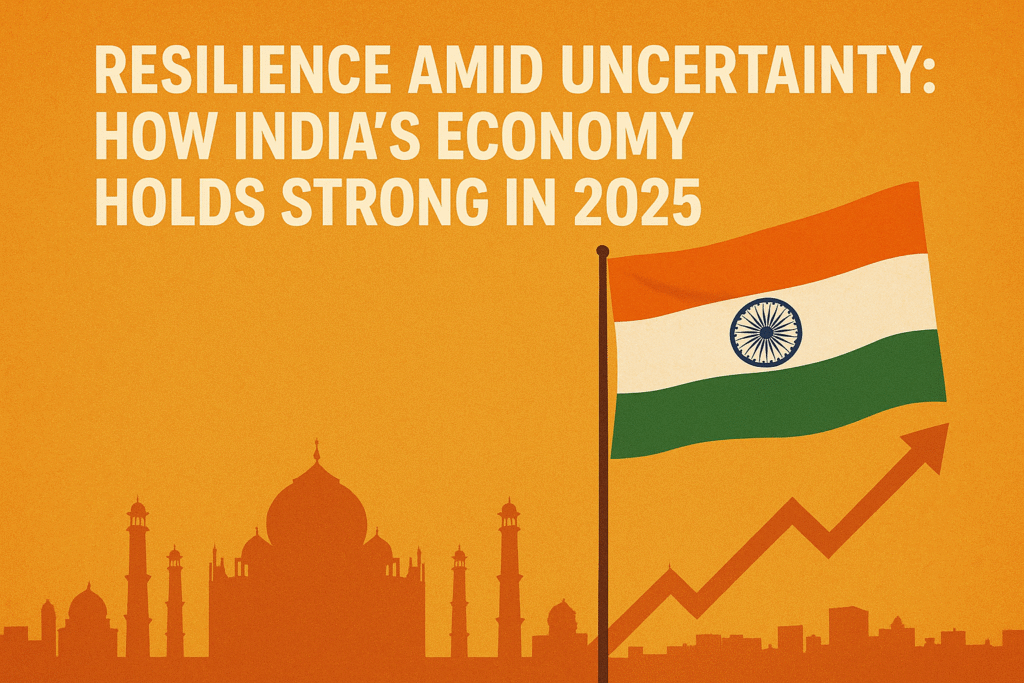Despite global headwinds, India’s economy in 2025 is a story of remarkable resilience. Explore the key pillars of growth—from digital transformation to manufacturing might—that are insulating the nation and positioning it as a future global leader.
The Global Anomaly
In a world grappling with sluggish growth, persistent inflation, and geopolitical fragmentation, one major economy continues to defy gravity. As advanced nations nervously eye recession risks and emerging markets struggle with capital flight, India’s economy in 2025 stands as a beacon of resilience and dynamic expansion. The International Monetary Fund (IMF) and World Bank projections consistently place India at the top of the global growth table, not as a fleeting phenomenon, but as a sustained trend.
This resilience is not accidental. It is the deliberate outcome of a multi-year, multi-pronged structural transformation that has fortified the nation against external shocks. While the term “uncertainty” defines the global economic mood, “opportunity” is the watchword within India. This article delves deep into the anatomy of this economic strength, moving beyond the headline GDP numbers to uncover the fundamental pillars—digital public infrastructure, a manufacturing renaissance, strategic fiscal policy, and a demographic dividend in full swing—that are collectively future-proofing India’s economy and cementing its role as an indispensable engine of global growth in 2025 and beyond.
The Macro Picture – Navigating Global Headwinds with Domestic Strength
To understand India’s position in 2025, one must first acknowledge the global challenges it successfully navigates.
- Tighter Global Financial Conditions: The era of low interest rates is over. The U.S. Federal Reserve’s policy continues to suck capital from emerging markets. Yet, India’s foreign exchange reserves remain robust, comfortably exceeding $600 billion, acting as a massive buffer against currency volatility and providing the Reserve Bank of India (RBI) with ample firepower to ensure stability.
- Geopolitical Fragmentation and Supply Chain Rewiring: The post-pandemic world is bifurcating into competing blocs. Rather than being a victim of this “China+1” strategy, India has emerged as its primary beneficiary. Companies are no longer asking if they should diversify from China, but how quickly they can establish a footprint in India.
- Commodity Price Volatility: As a net importer of oil, India remains vulnerable to energy shocks. However, strategic initiatives like diversifying energy sources, negotiating long-term supply contracts, and the strategic release from reserves have helped mitigate the impact on domestic inflation and the current account deficit.
Despite these powerful headwinds, the core domestic engine of India’s economy—its vast and growing consumer market—continues to fire on all cylinders, providing a stable foundation for growth that is the envy of the world.
The Digital Revolution – The Bedrock of Formalization and Efficiency
The single greatest structural shift underpinning India’s economic resilience is its groundbreaking digital public infrastructure (DPI). This is not merely a tech initiative; it is a complete rewiring of the economic nervous system.
1. The India Stack: A Trilogy of Transformation
This trio of platforms has democratized access, boosted transparency, and spurred formalization like no policy ever could.
- Aadhaar (Digital Identity): With over 1.3 billion citizens biometrically verified, Aadhaar has eliminated ghost beneficiaries and ensured that government welfare payments (DBT) reach the intended recipients directly, saving an estimated $33 billion in leakage.
- Unified Payments Interface (UPI) (Digital Payments): The crown jewel of India’s digital revolution. UPI has made digital payments instantaneous, free, and accessible to everyone with a smartphone. In 2025, UPI processes billions of transactions monthly, not just in urban centers but in the smallest villages. It has formalized cash-based transactions, bringing small businesses into the digital economy and providing an unprecedented data trail for credit assessment.
- Account Aggregator (AA) Framework (Digital Data Mobility): The next frontier. The AA framework allows individuals to securely share their financial data (bank statements, tax returns, GST filings) with lenders and financial institutions with their consent. This breaks down data silos, enabling sophisticated risk pricing and making credit accessible to millions of SMEs and individuals previously deemed “unbankable.”
2. The Startup and Fintech Explosion:
This digital infrastructure has been the launchpad for a world-class innovation ecosystem. India is now home to the third-largest startup ecosystem globally, with over 100 unicorns. Fintech companies are leveraging the India Stack to offer revolutionary products in lending, insurance, and investment, pushing traditional banks to innovate and dramatically expanding the pool of available capital.
This digital foundation has created a more efficient, transparent, and inclusive economy, making it inherently more resilient to shocks.
The Manufacturing Renaissance – From ‘Make in India’ to ‘Make for the World’
For decades, India’s growth was services-led. The pivotal development for India’s economy in 2025 is the successful ignition of its manufacturing sector, driven by a powerful combination of policy and pragmatism.
1. The Production-Linked Incentive (PLI) Scheme:
This is the masterstroke. The PLI scheme offers financial incentives to companies across 14 key sectors (from electronics and pharmaceuticals to drones and white goods) based on incremental sales from products manufactured in India. It is not a blanket subsidy; it is a targeted, performance-based tool that has successfully attracted both domestic and global giants.
2. China+1: From Strategy to Reality:
Global corporations have learned the hard lesson of supply chain over-concentration. India, with its large domestic market, democratic credentials, and improving infrastructure, is the natural alternative.
- Electronics: India is on track to become the second-largest manufacturer of mobile phones globally. Giants like Apple, through its partners Foxconn and Tata, are now producing iPhones worth billions of dollars in India for both domestic consumption and export.
- Semiconductors: Recognizing its strategic importance, India has launched a multi-billion dollar Semicon India program, offering fiscal support for establishing semiconductor fabrication and assembly plants. While a long-term play, it signifies a serious commitment to technological sovereignty.
- Renewable Energy & EVs: India is building a holistic ecosystem for electric vehicles and solar panel manufacturing, positioning itself as a green energy hub.
3. Infrastructure Leap:
The massive push on infrastructure—roads, railways, ports, and logistics under the PM Gati Shakti plan—is directly addressing the historic bottlenecks that hampered manufacturing competitiveness. Improved logistics slash costs and turnaround times, making “Make in India” a viable proposition for global export markets.
The Fiscal and Monetary Tango – A Delicate Balance
The management of India’s economy is a testament to prudent and proactive policymaking.
- The Reserve Bank of India (RBI): The central bank has expertly walked the tightrope between controlling inflation and supporting growth. Its data-dependent approach, using a flexible inflation targeting framework, has ensured that price rises remain within a manageable band, preventing the economy from overheating without crashing it.
- Government’s Fiscal Prudence: Despite the need for high public investment, the government has committed to a path of fiscal consolidation. The budget deficit is on a gradual downward trajectory, reassuring bond markets and rating agencies that the growth is not being built on a mountain of unsustainable debt. This fiscal discipline provides crucial “policy space” to respond to any future crises.
This coordinated and credible approach from monetary and fiscal authorities has built immense trust among international investors, who see India as a managed, relatively low-risk bet in the emerging market universe.
The Human Capital Advantage – Demographics as Destiny
A nation’s true wealth is its people. India’s demographic profile is its ultimate strategic asset.
- A Youthful Population: With a median age of 28, India is a remarkably young nation at a time when its major peers (China, the USA, Europe) are rapidly aging. This provides a vast and growing labor force and a consuming class that will drive demand for decades.
- The Skilling Revolution: Recognizing that a large population is only an asset if it is skilled, the government and private sector have launched massive upskilling initiatives (e.g., the Skill India Mission). The focus is on aligning education with the needs of modern industry, from coding and data analytics to advanced manufacturing techniques.
- The English-Speaking Edge: India’s large English-speaking, tech-literate workforce gives it a colossal advantage in attracting global capability centers (GCCs), R&D hubs, and service exports, further embedding it into the global value chain.
Challenges on the Path – The Road Ahead is Not Without Bumps
This resilient growth story is not without its vulnerabilities. A honest assessment is crucial.
- Jobless Growth? The critical challenge is creating enough high-quality, formal-sector jobs to absorb the millions of young people entering the workforce each year. Manufacturing and export-led growth is the key to solving this puzzle.
- Income and Regional Inequality: The benefits of growth must be spread more evenly across states and between urban and rural areas. Agricultural reforms and boosting rural incomes are essential for balanced development.
- The Climate Imperative: As a country highly vulnerable to climate change, India must balance its development goals with its commitment to net-zero by 2070. This requires massive investments in green energy, adaptation, and sustainable agriculture.
Conclusion: The Indispensable Economy
The narrative around India’s economy in 2025 is one of confident resilience amid global uncertainty. The nation has moved from being a perennial “promising” story to a “performing” reality. The combination of its digital backbone, manufacturing ambition, prudent macro-management, and demographic dynamism has created a virtuous cycle of growth, investment, and innovation.
While challenges remain, the trajectory is clear. India is no longer just an emerging market; it is a strategic global player and a stabilizing force in the world economy. For investors, it represents the world’s last great untapped mass market. For global corporations, it is the most critical piece of any supply chain diversification strategy. For the world, a strong, stable, and growing India is not just beneficial—it is essential. The decade belongs to India, and 2025 is the year this truth becomes undeniable.


